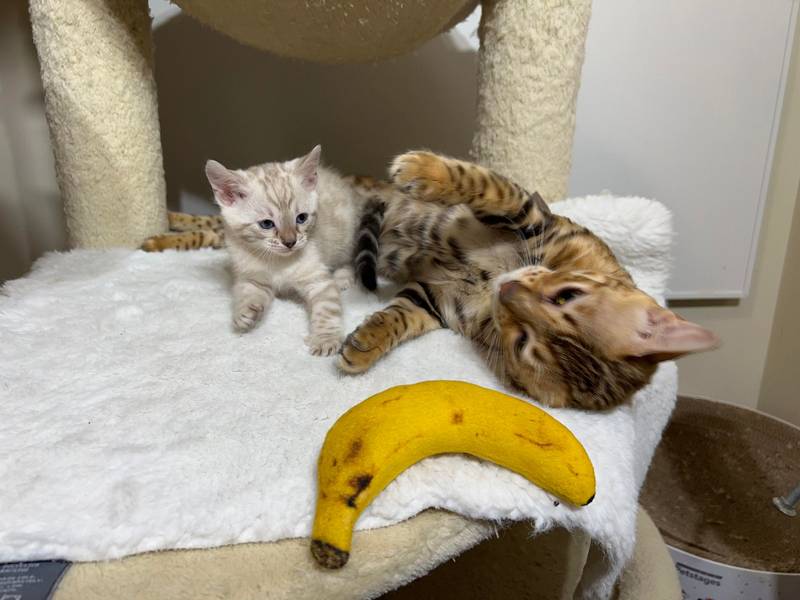Bringing home a bengal kitten in New York
Once your home is set up for your bengal kitten, it’s time for the exciting part – taking them home! You’ll need a sturdy and well ventilated cat carrier for bringing your kitten home in the car, which will need to be secured with a seatbelt once your kitten is inside.
Most kittens aren’t keen on being in a cat carrier, especially as their environment is new and strange to them. To keep them calm, consider placing a blanket or item from their home inside. Cats are heavily reliant on scent and will settle much quicker if their surroundings smell familiar.
How to transport your kitten home in the car
- Ask the person you’re collecting the kitten from to limit food for a couple of hours before the journey to avoid vomiting or toileting on the way home.
- Make sure the cat carrier is upright and secured with a seatbelt.
- Keep your heating or air conditioning away from your cat when you’re travelling.
- Drive smoothly and safely with as little noise as possible.
- Don’t leave your cat in the car unattended, particularly if the weather is hot.
- Travel straight home so that your kitten can get settled
Setting up your kitten’s space
Before collecting your bengal kitten, you’ll need to set up a designated space for them to settle in. Pick a quiet area away from busier (and noisier) areas and make sure they have the following items nearby.
- An area for food and a separate one for water
- A litter tray placed away from their food area (in a quiet location)
- A place to hide – a cardboard box or cat igloo will do
- Access to a high spot – kittens love to look around from up high. A sturdy shelf is perfect
- A suitable space to sleep, either with blankets or a cosy bed
- A scratching post
- A few kitten-safe toys to keep them entertained – a fishing rod is ideal
- Remember to secure any areas in the room you don’t want a kitten to enter – from cupboards to secret hiding holes!
How to get a bengal kitten used to a new home in New York
Once you’re home safely, it is time to gently introduce your kitten to their new environment. Give them the freedom to explore their new room, toys and items – no doubt giving them all a good sniff! If they choose to hide, sit quietly in the room and gently talk to them rather than forcing them out from their hiding space. It is completely natural for kittens to hide initially in a strange new environment.
For the first few days, limit them to just a couple of rooms initially so that they don’t feel overwhelmed. As they become more confident, you can introduce them to other areas of the house.
Introducing your kitten to children and the family
Once your kitten feels confident with you, you can gradually introduce other members of the family to them. While it is easy to get excited, it is important to remember to introduce people at your kitten’s pace – if they’re shy, it can be overwhelming for them to meet everyone at the same time.
Children are bound to be excited about the arrival of a new kitten. Before your little ones meet your kitten, prepare them by telling them to be gentle and calm. It is important that the kitten comes to them initially and they’re shown how to interact gently with them. Kittens also need a lot of sleep and will need to be left alone to rest, especially as they get used to their new home.
As your kitten becomes more comfortable, they’ll enjoy the playfulness of being around children. Naturally, kittens use their teeth and claws – making sure that you play with your kitten with appropriate toys instead of your hands and feet is important, particularly as their teeth and claws get bigger! Avoid using your fingers to encourage a cat in your direction too.
What should I feed my kitten?
If you know what your kitten has been eating in their previous home, it is advised to keep feeding them the same food at the same times. Familiar scents and tastes will help your cat to settle in gradually – and they’ll be more likely to eat what you’re providing them with!
If you’re unsure, you might feel overwhelmed at the numerous cat food brands at your local supermarket! Remember to choose food designed for cats, staying away from dog food or food intended for humans. Opt for a ‘complete’ food formulated specially for kittens. This will provide all the nutrients and minerals that your kitten needs for growing.
How often do I need to feed my kitten?
Kittens are energetic with small stomachs, so it is best to feed them little and often. When your kitten first arrives, aim to check their food and replace it four times a day – as well as providing plenty of fresh water. As they get older, you’ll get used to the amount that they eat and when. Cats older than six months should be fine if they’re fed twice a day while older cats may only need their food topping up once a day.

